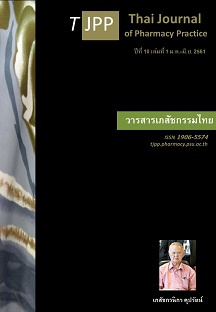บทบาทใหม่ของยาโอลาพาริบกับการรักษามะเร็งรังไข่ชนิดเยื่อบุผิว
Main Article Content
บทคัดย่อ
โรคมะเร็งรังไข่ชนิดเยื่อบุผิวเป็นมะเร็งรังไข่ชนิดหนึ่งที่พบได้มากที่สุด การรักษาโรคนี้ประกอบไปด้วยการผ่าตัดและการรักษาด้วยยาเคมีบำบัดซึ่งขึ้นอยู่กับระยะของโรค สูตรยาเคมีบำบัดสูตรแรกประกอบด้วยยากลุ่ม platinum เป็นยาหลักร่วมกับยาเคมีบำบัดอื่น ๆ อย่างไรก็ดีผู้ป่วยบางรายอาจล้มเหลวจากการรักษาด้วยยากลุ่มนี้ ยากลุ่ม poly (adenosine diphosphate [ADP]-ribose) polymerase (PARP) inhibitors คือ olaparib ออกฤทธิ์ยับยั้งกระบวนการซ่อมแซม DNA ของเซลล์มะเร็ง และเหนี่ยวนำกระบวนการอะพอพโทซิสของเซลล์มะเร็งที่เกิดการกลายพันธุ์ของยีน breast cancer type 1 susceptibility protein (BRCA1) หรือ ยีน BRCA2 (BRCA1/2 mutation) ยานี้มีข้อบ่งใช้สำหรับการรักษาผู้ป่วยมะเร็งรังไข่ชนิดเยื่อบุผิวที่มียีน BRCA ขาดหายไปหรือคาดว่าจะขาดหายไป (BRCA mutation) และล้มเหลวจากการรักษาด้วยยาเคมีบำบัดมากกว่าหรือเท่ากับ 3 สูตรขึ้นไป ขนาดยาที่ใช้สำหรับ olaparib ชนิดแคปซูล คือ 400 มิลลิกรัม วันละ 2 ครั้ง และชนิดเม็ด คือ 300 มิลลิกรัม วันละ 2 ครั้ง การวิจัยพบว่า ผู้ป่วยตอบสนองต่อการรักษา (objective response rate) คิดเป็นร้อยละ 34 นอกจากนี้ยังพบว่า ผู้ป่วยร้อยละ 23 มีผลตอบสนองเป็น stable disease อย่างน้อยเป็นระยะเวลา 16 สัปดาห์หลังเริ่มการรักษาด้วย olaparib แบบยาเดี่ยว olaparib ถูกเมแทบอลิซึมโดยเอนไซม์ cytochrome P450 (CYP450) จึงควรหลีกเลี่ยงการใช้ olaparib ร่วมกับยาที่ออกฤทธิ์ยับยั้งหรือกระตุ้นการทำงานของเอนไซม์ CYP3A4/5 เช่น itraconazole และ rifampicin การศึกษาในอดีตพบรายงานอาการอันไม่พึงประสงค์ในผู้ป่วยที่ใช้ olaparib ในระดับน้อยถึงปานกลาง โดยมีอาการชั่วคราวและสามารถแก้ไขได้ ได้แก่ คลื่นไส้ (ร้อยละ 71) อ่อนเพลีย (ร้อยละ 52) อาเจียน (ร้อยละ 34) ท้องเสีย (ร้อยละ 27) ปวดท้อง (ร้อยละ 25) และโลหิตจาง (ร้อยละ 21) อาการดังกล่าวมักจะพบในช่วงหนึ่งเดือนแรกหลังเริ่มใช้ olaparib สำหรับอาการไม่พึงประสงค์ระดับรุนแรงนั้นได้แก่ myelodysplastic syndrome และ acute myeloid leukemia
Article Details
ผลการวิจัยและความคิดเห็นที่ปรากฏในบทความถือเป็นความคิดเห็นและอยู่ในความรับผิดชอบของผู้นิพนธ์ มิใช่ความเห็นหรือความรับผิดชอบของกองบรรณาธิการ หรือคณะเภสัชศาสตร์ มหาวิทยาลัยสงขลานครินทร์ ทั้งนี้ไม่รวมความผิดพลาดอันเกิดจากการพิมพ์ บทความที่ได้รับการเผยแพร่โดยวารสารเภสัชกรรมไทยถือเป็นสิทธิ์ของวารสารฯ
เอกสารอ้างอิง
2. International Agency for Research on Cancer. Globocan 2012: Estimate cancer incidence mortality and prevalence worldwide in 2012 [online]. 2012. [cited Dec 9, 2016]. Available from: globocan .iarc.fr/Default.aspx.
3. National Comprehensive Cancer Network. NCCN Clinical Practice Guidelines in Oncology: ovarian cancer including fallopian tube cancer and primary peritoneal cancer version 2.2015. [online]. 2015. [cited Dec 9, 2016]. Available from: www.nccn.org/ professionals/physician_gls/pdf/ovarian.pdf.
4. U.S. Food and Drug Administration. FDA approves Lynparza to treat advanced ovarian cancer [online]. 2014. [cited Dec 9, 2016]. Available from: wayback. archive-it.org/7993/20170111160837/https://www.fd a.gov/NewsEvents/Newsroom/PressAnnouncemen ts/ucm427554.htm.
5. Ushijima K. Treatment for recurrent ovarian cancer-at first relapse. J Oncol. 2010;2010:497429. doi: 10.1155/2010/497429
6. Garcia A, Singh H. Bevacizumab and ovarian cancer. Ther Adv Med Oncol. 2013;5:133-41.
7. Underhill C, Toulmonde M, Bonnefoi H. A review of PARP inhibitors: from bench to bedside. Ann Oncol. 2011;22:268-79.
8. Jagtap P, Szabo C. Poly(ADP-ribose) polymerase and the therapeutic effects of its inhibitors. Nat Rev Drug Discov. 2005;4:421-40.
9. Mersch J, Jackson MA, Park M, Nebgen D, Peterson SK, Singletary C, et al. Cancers associated with BRCA1 and BRCA2 mutations other than breast and ovarian. Cancer. 2015;121:269-75.
10. Gunderson CC, Moore KN. Olaparib: an oral PARP-1 and PARP-2 inhibitor with promising activity in ovarian cancer. Future Oncol. 2015;11:747-57.
11. Chase DM, Patel S, Shields K. Profile of olaparib in the treatment of advanced ovarian cancer. Int J Womens Health. 2016;8:125-9.
12. Rolfo C, Swaisland H, Leunen K, Rutten A, Soete- kouw P, Slater S, et al. Effect of food on the pharma cokinetics of olaparib after oral dosing of the capsule formulation in patients with advanced solid tumors. Adv Ther. 2015;32:510-22.
13. Dean E, Middleton MR, Pwint T, Swaisland H, Carmichael J, Goodege-Kunwar P, et al. Phase I study to assess the safety and tolerability of olaparib in combination with bevacizumab in patients with advanced solid tumours. Br J Cancer. 2012;106:468-74.
14. Chen Y, Zhang L, Hao Q. Olaparib: a promising PARP inhibitor in ovarian cancer therapy. Arch Gynecol Obstet. 2013;288:367-74.
15. Plummer R, Swaisland H, Leunen K, van Herpen CM, Jerusalem G, De Greve J, et al. Olaparib tablet formulation: effect of food on the pharmacokinetics after oral dosing in patients with advanced solid tumours. Cancer Chemother Pharmacol. 2015; 76: 723-9.
16. Pujade-Lauraine E, Ledermann JA, Selle F, Gebski V, Penson RT, Oza AM, et al. Olaparib tablets as maintenance therapy in patients with platinum-sensitive, relapsed ovarian cancer and a BRCA1/2 mutation (SOLO2/ENGOT-Ov21): a double-blind, randomised, placebo-controlled, phase 3 trial. Lancet Oncol. 2017;18:1274-84.
17. Brown JS, Kaye SB, Yap TA. PARP inhibitors: the race is on. Br J Cancer. 2016;114:713-5.
18. Kim G, Ison G, McKee AE, Zhang H, Tang S, Gwise T, et al. FDA Approval Summary: Olaparib mono- therapy in patients with deleterious germline brca-mutated advanced ovarian cancer treated with three or more lines of chemotherapy. Clin Cancer Res. 2015;21:4257-61.
19.Domchek SM, Aghajanian C, Shapira-Frommer R, Schmutzler RK, Audeh MW, Friedlander M, et al. Efficacy and safety of olaparib monotherapy in germline BRCA1/2 mutation carriers with advanced ovarian cancer and three or more lines of prior therapy. Gynecol Oncol. 2016;140:199-203.
20. Oza AM, Cibula D, Benzaquen AO, Poole C, Mathijssen RH, Sonke GS et al. Olaparib combined with chemotherapy for recurrent platinum-sensitive ovarian cancer: a randomised phase 2 trial. Lancet Oncol. 2015;16:87-97.
21. Liu JF, Barry WT, Birrer M, Lee JM, Buckanovich RJ, Fleming GF, et al. Combination cediranib and olaparib versus olaparib alone for women with recurrent platinum-sensitive ovarian cancer: a randomised phase 2 study. Lancet Oncol. 2014;15: 1207-14.
22. Kaufman B, Shapira-Frommer R, Schmutzler RK, Audeh MW, Friedlander M, Balmana J, et al. Olaparib monotherapy in patients with advanced cancer and a germline BRCA1/2 mutation. J Clin Oncol. 2015;33:244-50.
23. Dirix L, Swaisland H, Verheul HM, Rottey S, Leunen K, Jerusalem G, et al. Effect of itraconazole and rifampin on the pharmacokinetics of olaparib in patients with advanced solid tumors: results of two phase i open-label studies. Clin Ther. 2016; 38: 2286-99.
24. Ledermann J, Harter P, Gourley C, Friedlander M, Vergote I, Rustin G, et al. Olaparib maintenance therapy in patients with platinum-sensitive relapsed serous ovarian cancer: a preplanned retrospective analysis of outcomes by BRCA status in a randomised phase 2 trial. Lancet Oncol. 2014; 15: 852-61.


